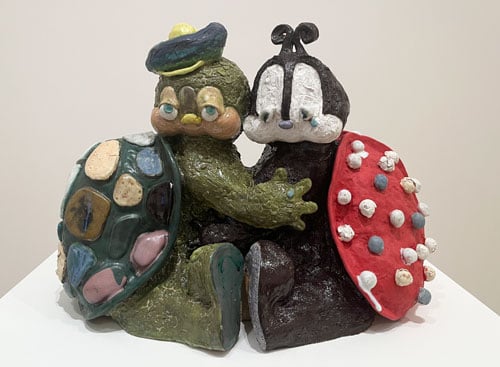BIENNIAL BLAHS
%2c-2024.jpg?upscale=true&width=1200&upscale=true&name=02-Na-Mira_Sugungga-(Hello)%2c-2024.jpg)
Na Mira's video installation, Sugungga (Hello), 2024, in Made in L.A. 2025. (Paul Soto)
Years ago, someone — I can’t remember who — left a comment on one of my social media accounts that read: “LA is a punk zine.” It’s an expression I have gleefully appropriated because it couldn’t be more on point. LA is bits and pieces of other places held together by untidy seams. It’s uncouth and unbothered with formalities. Often, the best things the city has to offer — food, shopping, culture — come from a dank strip mall. And there’s the humor, which is dark and weird. In 2020, during the marches for Black lives, a Latinx punk band rocked out from the back of a pick-up as a form of protest. It was defiant, absurd, cinematic.
The latest iteration of the Hammer Museum’s biennial, Made in L.A. 2025, does not quite attain the heights of punk zine. Instead, it feels more like LA as an art school faculty cocktail: stiff, well-mannered, spare.
The show, organized by independent curator Essence Harden, and the Art Institute of Chicago’s Paulina Pobocha, begins well enough. Greeting visitors to the museum are a series of bold wall paintings that recreate a series of murals painted by the late Alonzo Davis on the 110 Freeway in 1984. Outdoors, in the nook that fronts Wilshire, you’ll find a monumental inflatable of a worried-looking bear driving a pink convertible by Alake Shilling, whose work takes cartoonish figures and imbues them with humor and melancholy.

Alake Shilling, C'est la vie, mon ami, 2025. (Carolina A. Miranda)
But enter the galleries, and things unravel. There is heady conceptualism here; ceramics there, without a unifying thread to tie them together. I found myself struggling to make connections between artworks and between the art and LA. The excellent catalog — which includes worthwhile interviews with each of the artists — also includes a conversation between the curators in which they discuss the lack of theme. “‘What is the show about? What’s the theme?’” asks Pobocha rhetorically. “Our response: ‘It’s a lot of themes.’” In a relatively tight biennial of just 28 artists, “a lot of themes” is perhaps a few too many.
That said, I found myself intrigued by a number of works in the show. Kelly Wall’s sculptures employ elements of tourist kitsch as artistic material — like her fountain made from coffee cups installed right in front of the museum’s gift shop. And an enthralling two-hour video by Freddy Villalobos traces, in slow motion, the route taken by singer Sam Cooke’s body from the Hacienda Motel in South L.A., where he was killed, to the city morgue — a funereal portrait of the city.
If this rambling exhibition has a heart, it is the work of LA-born and bred Pat O’Neill. The artist is better known as an experimental filmmaker. (Water and Power, from 1989, is an enthralling meditation on the LA landscape and the water that feeds it.) The biennial focused on his lesser seen visual art: a ‘60s-era photographic series Cars and Other Problems, which wryly subvert California’s adoration of the automobile, as well as his early fiberglass sculptures — including Safer Than Springtime, from 1964, which features a wine cork (I think it’s a wine cork) and a giant, shiny pickle. The display made me wish some LA institution would take on a retrospective of this intriguing artist’s work — he’s bigger than a biennial.

Pat O'Neill, Los Angeles, c. 1960s. (Pat O'Neill)
As Made in L.A. was opening in Westwood, artist and writer Sammy Loren was staging a guerrilla show called Made in helLA 2025 at O-Town House, a small art space near MacArthur Park. Up for only 24 hours, it featured a small exhibition of artists he admired. (I appreciated the photographs of revelers in nightclubs by Anya GTA, printed on metal sheets.) For sale on a table by the door was Loren’s art tabloid, On the Rag, featuring a headline that read “Women Should Only Sleep With Hot Men.”
The show also jammed in music, performances, and panels. I caught novelist Chris Kraus, writer Luis Bauz, and photographer Reynaldo Rivera, talking about the exchanges between Mexico and LA.

Sophia Le Fraga, LATER/UGH, 2025. (Carolina A. Miranda)
Made in HelLA was congenial and chaotic. It also channeled the punk energy that eluded its namesake show across town.
🏙️🌆🌃
Made in L.A. 2025 is on view at the Hammer Museum through March 1st; hammer.ucla.edu.
Plus: Hyperallergic’s Matt Stromberg talks to five of the show’s artists (including Villalobos) about their works.